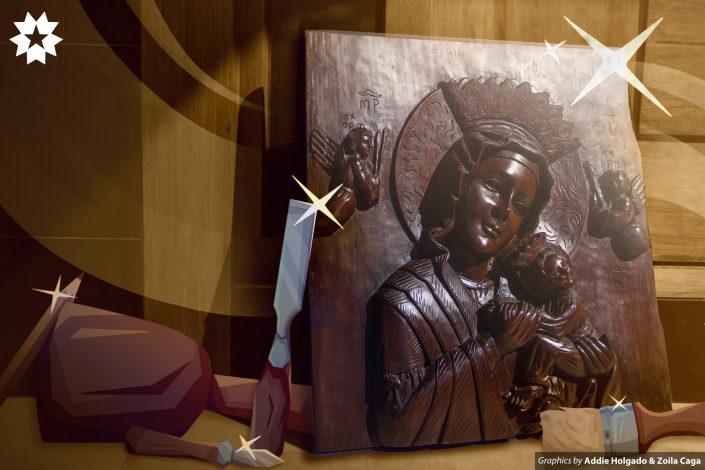What is left of the Filipino arts? In the current age of postmodern ideologies and minimalist art, the situation of our authentic crafts becomes depressingly grave. Reminiscent of our pre-Hispanic culture, what’s left of the Pinoy arts may also soon face extinction. But somewhere in the farther end of the province of Laguna, there are native arts that still survive. These arts signify this small Tagalog town named Paete.
Paete, Laguna
The word Paete (Pa-e-te) originated from the Tagalog term “paet”, which is “chisel” in English translation. A paet is used as the fundamental tool in woodcarving. This illustrates how Paete’s prime art-woodcrafts-centers the life of this town. Like most Tagalog provinces, Paete has its share of Pinoy history. In the year 1864, its most focal landmark was built – the Santiago Apostol Church. The construction of this church paved way for the awareness and breakthrough of Paetenian arts in the mainstream. And today, the legacy of their art lives on.
The Arts of Paete
As old as the Spanish conquests in the country, the Paetenian native arts remain alive and undamaged. They struggle against the outgrowth of contemporary trends, as compared to most of our culture that somehow vanished in time.
The art of Ukit, or woodcarving, placed Paete on the world map. Most of these Paetenian woodcrafts are carvings of pu-ons or images of Christian saints. Viewing these pu-ons, enshrined in the Paete church, is in itself a rich spiritual experience, hence its popularity with European travelers.
This town has its own version of celebrities. One of them is Mariano Madrinan. Madrinan, a humble artist, gave pride to his town when he acquired the King Alfonso XII of Spain Medal for his Mater Dolorosa wood art in 1882. At present, the Mater Dolorosa symbolizes Paete as a place of Christian pilgrimage. It remains the central hallmark of Filipino Christianity. Another Paetenian artist is Ricardo Bagabaldo. One of his masterpieces is his version of the Last Supper. He firmly believed that Filipinos could excel in the art of woodcarving. And it isn’t necessary for us to fly away to Italy to see excellent craftsmanship or to even learn Da Vinci’s art.
Recall the good old days of childhood. Paete’s next big thing caters to the taste and preference of the youth. Taka, more popularly known as papier-mâché, is the art of creating toys made out of paper. In the early 1970s, taka came of age. Exported to Germany as souvenir mascots for the 1974 Olympic Games, taka then assumed a place in Pinoy arts. Plus, some of the most popular crafts that came from Paete were the bakya (wooden shoes), and the yo-yo. Paete has created yo-yos that were well varnished. Many even thought that the Paetenian yo-yos were made in France.

The Paeteno
“Once you learn the art, you will survive anywhere you go. I am proud to tell anybody that I come from a small town where citizens are full of talents and abilities,” as Ricardo Bagabaldo, a renowned Paetenian woodcarver, relates. This justifies the immortality of their crafts. The nature of survival drives the artist and his craft. Paetenos undeniably have a passion for their crafts. Thus, making their quality of work world-renowned. Just like a gardener with green thumb, they seem to have the inborn capability to generate creative masterpieces. Moreover, it has been a tradition for most Paetenian families to pass on their crafts to the younger generation. They consider this an artistic heritage. Better yet, it is because of this tradition that the continuing existence of the arts of Paete is maintained.
Aesthetic Dilemmas
However, there are actual circumstances that attack the modern presence of Paetenian crafts. First, various handicraft industries are slowly diminishing. This will cause the weakening of Paete’s tourism and export. Second, most of the best artists opt to migrate. This is due to the fact that the demand for artists is greater in foreign lands. Third, Paetenian artistic ideas are pirated. There are foreign companies that get techniques from Paete without proper recognition. These carvers create original wood carvings, but foreign visitors often get ideas from designs and use them in mass production. Then, they would market the crafts as their own. To sum up, the arts continue to struggle against the outgrowth of present-day trends, such as the contemporary Western arts, digital technology, capitalist economy, and of course, globalism.
The Art Beyond
There are countless reasons for the dilemmas of Paete, such as our low patriotism for the Pinoy crafts and the ever-changing trends in society. But these do not easily stop the Paetenian artists from cultivating their art, for they have withstood the test of time. This makes them an essential part of the Filipino arts. And as the earth continues to rotate, culture will inescapably be shaped, manipulated, and formed. Thus, more elements of it may be gained or, alarmingly, lost again.
